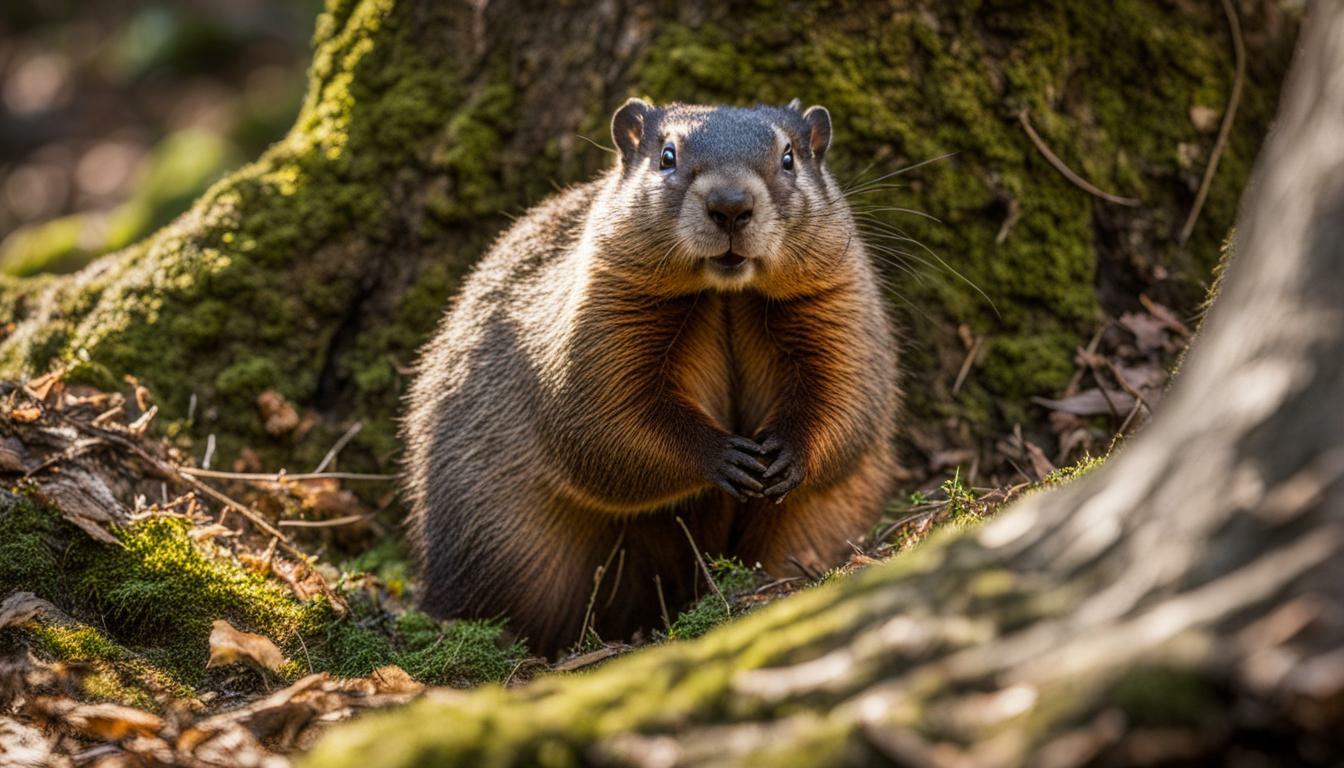Groundhogs, also known as woodchucks or whistlepigs, are fascinating creatures with unique abilities. They are primarily ground-dwelling animals, but they have the surprising capability to climb trees using their strong claws. However, tree climbing is not a common behavior for groundhogs, and they typically only do so when escaping predators or accessing food sources. Groundhogs are more renowned for their impressive burrow-digging skills, as they create intricate systems for shelter and hibernation. In addition to their climbing abilities, groundhogs are also proficient swimmers.
Key Takeaways:
- Groundhogs have the ability to climb trees using their strong claws.
- Tree climbing is not a regular behavior for groundhogs; they do it to escape predators or access food.
- Groundhogs are well-known for their impressive burrow-digging abilities.
- Groundhogs are also skilled swimmers.
- While groundhogs can climb trees, it is not a daily routine for them.
Groundhog Behavior and Habitat
Groundhogs are primarily ground-dwelling animals that are known for their burrow-digging abilities. These creatures, also known as woodchucks or whistlepigs, are well-adapted to life on the ground and are commonly found in open fields, meadows, and woodlands across North America.
They exhibit a range of interesting behaviors in their natural habitat. Groundhogs are diurnal, meaning they are active during the daytime. They spend a significant amount of time foraging for food, mainly vegetation such as grasses, leaves, and berries. This herbivorous diet is supplemented with the occasional insect or snail.
When it comes to their burrow-digging abilities, groundhogs are truly impressive. They create complex underground tunnel systems that can extend up to several feet below the surface. These burrows serve as their primary shelter, providing protection from predators and extreme weather conditions. Groundhogs also use their burrows for hibernation during the winter months, where they enter a state of deep sleep to survive the cold.
The Role of Habitat in Groundhog Behavior
The preferred habitat for groundhogs includes areas with loose soil that is suitable for burrowing. They are commonly found in grassy areas adjacent to forests or near water sources. Groundhogs are territorial creatures and mark their burrow entrances with piles of dirt, which serve as a warning to other groundhogs.
While groundhogs primarily dwell on the ground, they do possess the ability to climb trees. However, this behavior is not a regular part of their daily routine. They typically climb trees when they feel threatened by predators or when they need to access food sources that may be located in the branches. Their strong claws enable them to ascend tree trunks with relative ease, but they are not as proficient at climbing as animals such as squirrels.
| Groundhog Behavior and Habitat | Groundhog Adaptations for Tree Climbing |
|---|---|
|
|
In addition to their ground-dwelling and tree-climbing abilities, groundhogs are adept swimmers. They can navigate through water bodies, such as streams or ponds, using their powerful limbs and streamlined bodies. This adaptability allows groundhogs to thrive in various environments and survive potential threats.
In summary, groundhogs exhibit fascinating behavior and adapt well to their habitat. While their primary mode of living is on the ground, they have the capability to climb trees when necessary. However, this behavior is not as prevalent as their renowned burrow-digging skills. Groundhogs are remarkable creatures that continue to captivate observers with their unique behaviors and adaptations.
The Burrow-Diggers
Groundhogs are skilled burrowers and create complex underground systems for various purposes. These underground homes, known as burrows, serve as their primary shelters and hibernation sites. Groundhogs possess impressive burrow-digging abilities, allowing them to excavate deep tunnels and chambers beneath the ground. These burrows feature multiple entrances and exits, providing the groundhogs with easy access and escape routes.
Groundhog burrows are essential for their survival and serve a variety of functions. They provide protection from predators, harsh weather conditions, and extreme temperatures. The burrows also serve as nesting chambers for raising their young, known as kits. These underground dwellings are equipped with different chambers for specific purposes, such as sleeping, eating, and bathroom facilities, ensuring a well-organized living space for the groundhog community.
Furthermore, groundhog burrows can extend up to several feet in depth and length, containing intricate systems of tunnels and chambers. These systems are created by the groundhogs’ powerful claws and their ability to dig through various types of soil. The burrows can span several meters, allowing groundhogs to move freely and navigate their underground realm with ease. This extensive burrow network also helps groundhogs find food sources, as they can connect to different areas, including nearby fields and gardens.
| Groundhog Burrow Features: |
|---|
| Multiple entrances and exits |
| Deep and extensive tunnel systems |
| Various chambers for different activities |
| Protection from predators and harsh weather |
| Connectivity to food sources |
While groundhogs are known for their extraordinary burrow-digging abilities, it is important to note that burrowing is their primary behavior, and climbing trees is not a common occurrence. However, these creatures have the agility and physical adaptations to climb trees when the need arises, such as evading predators or reaching food sources. Groundhogs’ versatile nature allows them to adapt to different situations and environments, making them fascinating creatures to study and observe.
Tree Climbing Among Groundhogs
While not a common behavior, groundhogs have been known to climb trees in certain situations. These ground-dwelling creatures have adapted strong claws that allow them to ascend tree trunks when necessary. Tree climbing for groundhogs primarily occurs when escaping predators or accessing food sources that are otherwise out of reach on the ground.
Groundhogs are more renowned for their burrow-digging abilities, as they create intricate underground systems for shelter and hibernation. These burrows serve as their primary habitat, providing protection from predators and weather conditions. However, in instances where groundhogs encounter threats from animals such as coyotes or foxes, they may instinctively take to the trees to escape danger.
Aside from their occasional tree-climbing escapades, groundhogs also possess surprising swimming abilities. They can swim across bodies of water, showcasing their adaptability in various environments. This ability to swim is another example of the resourcefulness and flexibility of these fascinating creatures.
In conclusion, while groundhogs are generally known for their burrow-digging skills, they are capable of climbing trees when necessary. Despite not being a common behavior, their ability to do so stems from their strong claws and serves as a survival mechanism when threatened by predators or when seeking inaccessible food sources. Groundhogs’ adaptability extends beyond tree climbing, and their swimming skills highlight their ability to thrive in diverse habitats.
| Groundhog Behavior | Tree Climbing | Burrow-Digging | Swimming |
|---|---|---|---|
| Groundhogs are primarily ground-dwelling animals. | While not common, groundhogs can climb trees to escape predators or access food. | Groundhogs are well-known for their impressive burrow-digging abilities. | Groundhogs possess surprising swimming skills and can navigate across bodies of water. |
Groundhog Adaptations for Tree Climbing
Groundhogs possess specific physical adaptations that assist them in climbing trees. While they are primarily ground-dwelling animals, their strong claws enable them to ascend tree trunks with relative ease. These claws provide them with a firm grip, allowing them to navigate the bark and find secure footing as they climb.
In addition to their claws, groundhogs have a compact and muscular body structure that aids in their tree climbing abilities. Their robust physique provides them with the strength and agility necessary to maneuver vertically and traverse branches. This physical adaptation allows groundhogs to escape from predators that may be unable to pursue them into the treetops.
Despite these adaptations, it’s important to note that tree climbing is not a frequent behavior for groundhogs. They typically reserve this activity for specific situations, such as evading danger or accessing food sources that may be available on branches. Groundhogs are more commonly known for their burrow-digging prowess, where they create extensive underground networks for shelter and hibernation.
Groundhog Physical Adaptations for Climbing Trees:
- Strong claws for gripping tree trunks and branches
- Compact and muscular body structure for agility and strength
Interestingly, groundhogs are not limited to land-based activities. They also possess the ability to swim, showcasing their adaptability in different environments. While their swimming skills may not be as well-known as their tree climbing or burrow-digging abilities, it highlights their versatility as animals.
In conclusion, groundhogs possess specific physical adaptations that allow them to climb trees, including their strong claws and muscular bodies. However, tree climbing is not a regular behavior for them and is typically reserved for specific situations. Understanding these adaptations and behaviors adds to our appreciation of the remarkable abilities of these fascinating creatures.
| Groundhog Adaptations for Tree Climbing |
|---|
| Strong claws |
| Compact and muscular body structure |
Tree Climbing vs. Burrow-Digging
While groundhogs are adept at climbing trees, it is not a behavior that occurs with the same frequency as burrow-digging. Groundhogs possess strong claws that allow them to grip tree trunks and ascend to higher branches when necessary. However, compared to their well-known burrow-digging tendencies, tree climbing is relatively rare.
Groundhogs primarily climb trees for two main reasons: to escape predators and to access food. When threatened by predators such as foxes or coyotes, groundhogs will seek refuge in trees as they are better equipped to navigate the branches than their pursuers. This behavior allows the groundhog to create a safe distance and increase its chances of survival.
In addition to predator avoidance, groundhogs may also climb trees in search of food. While they are primarily herbivorous and rely on plants for sustenance, groundhogs may occasionally venture up a tree to munch on fruits or leaves within their reach. However, it’s important to note that this behavior is not a regular part of their daily routine and occurs on an opportunistic basis.
Tree Climbing in Perspective
When considering the overall behavior of groundhogs, tree climbing is just one facet of their complex nature. Their expertise lies in the art of burrow-digging, where they create intricate underground systems that serve as shelter, hibernation sites, and even nurseries for their young. Burrow-digging is a regular and essential activity for groundhogs, allowing them to create a safe and comfortable environment for various stages of their lives.
In conclusion, while groundhogs are capable climbers, their tree climbing abilities should be seen in the context of their broader behaviors. Tree climbing is a means of survival and resource acquisition rather than a common occurrence. So, the next time you spot a groundhog perched on a tree branch, remember that its ability to climb trees is just one of the many fascinating aspects of their behavior.
| Groundhog Abilities Comparison | |
|---|---|
| Behavior | Frequency |
| Tree Climbing | Occasional |
| Burrow-Digging | Frequent |
| Swimming | Infrequent |
Groundhog Swimming Abilities
In addition to climbing trees and digging burrows, groundhogs are also capable swimmers. Despite their stocky build and short legs, these remarkable creatures display surprising aquatic skills. Groundhogs have been known to swim across bodies of water such as rivers and lakes, using their strong bodies and paddle-like feet to propel themselves through the water.
While swimming, groundhogs keep their bodies close to the surface, utilizing their long, flattened tails as a rudder to help with steering. Their dense fur provides insulation, allowing them to stay warm and buoyant while in the water. Groundhogs are adept at holding their breath, enabling them to remain submerged for a considerable amount of time while navigating their aquatic environment.
Groundhog swimming abilities are particularly useful when it comes to foraging for food. These resourceful creatures can swim to adjacent areas or even to small islands, expanding their food options. Swimming allows groundhogs to access vegetation, such as aquatic plants and grasses, that may not be available to them on land. It also provides a means of escape when facing potential threats, as groundhogs can quickly retreat to water bodies.
Groundhog Swimming Skills in Perspective
While groundhogs are certainly capable of swimming, it is important to note that swimming is not a primary or habitual behavior for them. Their swimming abilities are more of an occasional adaptation rather than a regular part of their daily routine. Groundhogs primarily rely on their burrow-digging and tree-climbing abilities to survive and navigate their environment.
In conclusion, groundhogs are multi-talented animals that possess the ability to swim, climb trees, and dig burrows. These traits enable them to adapt to various situations and environments, making them highly adaptable creatures. The next time you come across a groundhog, take a moment to appreciate its incredible capabilities and the fascinating behaviors that make it such a unique member of the animal kingdom.
| Groundhog Abilities | Examples |
|---|---|
| Tree Climbing | Occasional behavior for escaping predators or accessing food. |
| Burrow Digging | Creating large burrow systems for shelter and hibernation. |
| Swimming | Capable of swimming across bodies of water to forage for food and escape threats. |
Fascinating Groundhog Facts
Groundhogs possess various fascinating characteristics that make them intriguing subjects of study. Also known as woodchucks or whistlepigs, these curious animals are primarily ground-dwelling creatures. However, they are capable of surprising observers with their ability to climb trees. Groundhogs have strong claws that allow them to ascend tree trunks, although tree climbing is not a common behavior for them. They typically engage in this activity to escape from predators or to access food sources.
In addition to their tree-climbing skills, groundhogs are renowned for their impressive burrow-digging abilities. They create extensive burrow systems that serve as their shelter and hibernation sites. These burrows can have multiple chambers and tunnels, providing them with protection and safety. Groundhogs are skillful architects, capable of constructing elaborate underground homes.
Another surprising characteristic of groundhogs is their proficiency in swimming. Although they are primarily known as land-dwelling creatures, groundhogs are adapt at navigating through water. Their ability to swim enables them to cope with various environmental conditions, making them highly adaptable animals.
| Interesting Groundhog Facts: |
|---|
| Groundhogs can climb trees with their strong claws. |
| They are skilled burrow diggers, creating extensive underground homes. |
| Groundhogs are proficient swimmers, able to navigate through water. |
In conclusion, groundhogs possess a diverse range of characteristics that contribute to their unique nature. While their ability to climb trees may come as a surprise, it is not a regular part of their daily routine. Groundhogs are more renowned for their burrow-digging skills and their proficiency in swimming. These fascinating facts about groundhogs deepen our understanding of these remarkable creatures and highlight their adaptability in different environments.
Groundhog Tree Climbing in Perspective
Groundhog tree climbing, while interesting, is not a behavior that defines their daily lives. These furry creatures, also known as woodchucks or whistlepigs, are primarily ground-dwelling animals. However, they do possess the ability to climb trees using their strong claws. Tree climbing is not a common occurrence for groundhogs, but they may resort to it in certain situations.
Groundhogs primarily climb trees for two main reasons: escaping predators and accessing food. When faced with a threat from predators such as foxes or coyotes, groundhogs will seek refuge in the trees, using their climbing skills as a means of survival. Additionally, groundhogs may venture up trees to reach food sources such as berries or tender leaves that are otherwise inaccessible from the ground.
Although groundhogs are more renowned for their remarkable burrow-digging abilities, it is worth noting that they are also proficient swimmers. This adaptability in different environments showcases their versatility as a species. Groundhogs utilize their burrows as their primary shelters and hibernation sites, but they can also climb trees and navigate through water when the need arises.
| Behaviors | Characteristics |
|---|---|
| Burrow-digging | Groundhogs are adept at digging extensive burrow systems for shelter and hibernation. |
| Tree climbing | While not a regular behavior, groundhogs can climb trees using their strong claws. |
| Swimming | Groundhogs are capable swimmers and can navigate through water with ease. |
In conclusion, groundhogs have the ability to climb trees, but it is not a behavior that defines their daily lives. They primarily engage in tree climbing to escape predators or access food sources that are otherwise out of reach. Groundhogs are more commonly recognized for their impressive burrow-digging skills and adaptability as swimmers. These behaviors collectively contribute to the unique characteristics of this fascinating species.
Conclusion
Groundhogs’ ability to climb trees is a unique skill that they possess but is not a regular part of their behavior. These creatures, also known as woodchucks or whistlepigs, are primarily ground-dwelling animals. However, they have strong claws that allow them to ascend tree trunks when necessary.
Tree climbing is typically reserved for specific situations, such as escaping from predators or accessing food sources. Groundhogs are more famous for their impressive burrow-digging skills, as they create extensive underground systems for shelter and hibernation.
In addition to their tree-climbing abilities, groundhogs are surprisingly proficient swimmers. These adaptable creatures have the capacity to navigate through different environments with ease.
Overall, while groundhogs may surprise observers with their occasional tree-climbing skills, it is important to note that this behavior is not a common occurrence in their daily routine. Groundhogs’ natural habitat and behaviors are more centered around burrow-digging and utilizing their underground homes for safety and survival.
FAQ
Can groundhogs climb trees?
Yes, groundhogs are capable of climbing trees, although it is not a common behavior for them.
Why do groundhogs climb trees?
Groundhogs typically climb trees to escape predators or to access food sources.
Are groundhogs known for their burrow-digging abilities?
Yes, groundhogs are known for their impressive burrow-digging skills, which they use for shelter and hibernation.
Can groundhogs swim?
Yes, groundhogs are proficient swimmers.
What physical adaptations enable groundhogs to climb trees?
Groundhogs have strong claws and other relevant physical adaptations that aid them in climbing trees.
How does groundhog tree climbing compare to burrow-digging?
Groundhog tree climbing is less frequent than their burrow-digging behavior and serves different purposes.
What are some fascinating groundhog facts?
Groundhogs have unique behaviors and habits, such as tree climbing and burrow-digging, which make them fascinating creatures.
Why is groundhog tree climbing not a regular part of their daily routine?
Groundhog tree climbing is not a regular behavior because it is primarily used to escape predators or access specific food sources.
Can groundhogs climb trees in perspective of their overall behavior?
Groundhog tree climbing is a behavior that exists within the broader context of their overall behavior and is not a predominant activity.
What is the conclusion about groundhogs and tree climbing?
Groundhogs are capable of climbing trees, but it is not a typical behavior for them. Their primary focus is on burrow-digging and other ground-based activities.




